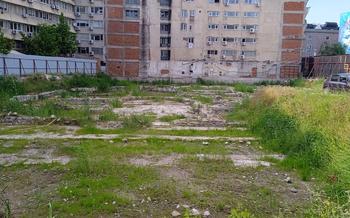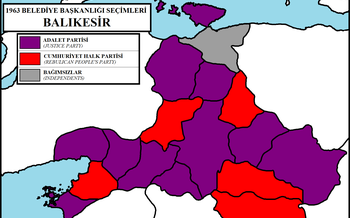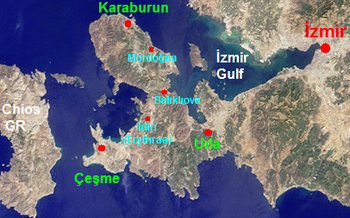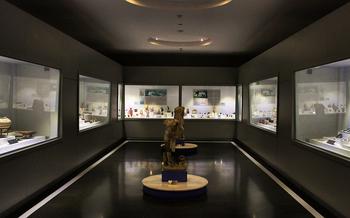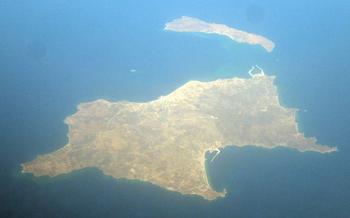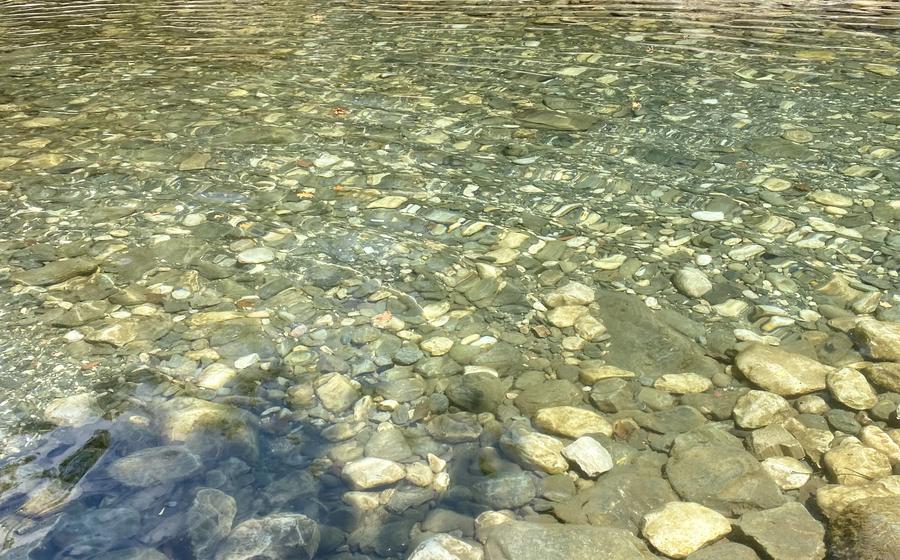
The Historical Olive Oil Factory in Burhaniye
- The Historical Olive Oil Factory in Burhaniye
- The History of Olive Oil Production in Turkey
- The Process of Olive Oil Production
- The Benefits of Olive Oil
- How to Use Olive Oil
- Tasting Olive Oil
- Storing Olive Oil
- Olive Oil Festivals
- The Olive Oil Museum
- The Olive Oil Market
- Olive Oil Recipes
- Cooking
- Baking
- Cosmetics
- The Olive Tree
- Olive Oil and the Turkish Culture
- The Future of Olive Oil Production in Turkey
- Insider Tip
The Historical Olive Oil Factory in Burhaniye
The Historical Olive Oil Factory in Burhaniye is a must-visit for anyone interested in the history of olive oil production in Turkey. The factory was built in the late 19th century and is one of the oldest surviving olive oil factories in the country. It has been in continuous operation since it was built and is still used to produce olive oil today.
The factory is a fascinating place to visit, and visitors can learn about the different stages of olive oil production, from the harvesting of the olives to the bottling of the finished product. The factory also has a museum that displays old olive oil-making equipment and artifacts.
The Historical Olive Oil Factory is located in the town of Burhaniye, which is about an hour's drive from the city of Balıkesir. The factory is open to the public for tours, and there is a small admission fee.
The History of Olive Oil Production in Turkey
Olive oil production has a long and rich history in Turkey, dating back to the ancient Greeks and Romans. In fact, Turkey is one of the world's largest producers of olive oil, and the Burhaniye region is one of the country's most important olive oil-producing regions.
The climate and soil conditions in the Burhaniye region are ideal for growing olives, and the region has a long tradition of olive oil production. Olive oil from Burhaniye is known for its high quality and unique flavor, and it is used in a variety of Turkish dishes.
For many years, olive oil was produced in Turkey using traditional methods. However, in recent years, the country's olive oil industry has become more modernized. Today, many olive oil producers in Turkey use modern equipment and techniques to produce olive oil, but they still maintain the traditional methods that have been passed down from generation to generation.
The Process of Olive Oil Production
Olive oil production is a complex and time-consuming process that requires careful attention to detail. The first step is to harvest the olives. This is typically done by hand, as machines can damage the fruit. Once the olives have been harvested, they are taken to the mill to be processed.
At the mill, the olives are washed and sorted. The good olives are then crushed into a paste. This paste is then mixed with water and churned to separate the oil from the water and solids. The oil is then collected and stored in stainless steel tanks.
The type of olive used, the climate, and the production method all affect the quality of the olive oil. The best olive oils are made from fresh, ripe olives that are processed quickly after harvesting. They are also produced using traditional methods, such as stone mills and cold pressing.
The different stages of olive oil production are as follows:
Harvesting: The olives are harvested by hand or machine. Washing: The olives are washed to remove any dirt or debris. Sorting: The olives are sorted to remove any damaged or unripe fruit. Crushing: The olives are crushed into a paste. Mixing: The paste is mixed with water and churned. Separation: The oil is separated from the water and solids. Storage: The oil is stored in stainless steel tanks.
The Benefits of Olive Oil
Olive oil has been praised for its health benefits since ancient times. It is a rich source of monounsaturated fats, which have been shown to reduce the risk of heart disease, stroke, and type 2 diabetes. Olive oil also contains antioxidants, which can help to protect cells from damage and reduce the risk of cancer.
In addition to its health benefits, olive oil also has a number of culinary benefits. It is a versatile oil that can be used in a variety of dishes. It has a fruity, peppery flavor that can enhance the taste of food. Olive oil is also a good source of Vitamin E, another antioxidant that helps protect cells from damage.
Olive oil has also been used for centuries in beauty products. It is a natural moisturizer that can help to improve the appearance of skin and hair. Olive oil can be used to make soaps, lotions, and creams. It can also be used to condition hair and make it more shiny and healthy.
How to Use Olive Oil
Olive oil has a wide range of culinary applications. It can be used for frying, sautéing, baking, and dressing salads. Olive oil is also a popular ingredient in marinades, sauces, and dips.
Cooking with Olive Oil
Olive oil is a healthy and flavorful oil that can be used to cook a variety of dishes. It has a high smoke point, which makes it ideal for frying and sautéing. Olive oil also adds a rich flavor to baked goods.
Baking with Olive Oil
Olive oil can be used to replace butter or shortening in baking recipes. It adds a moist texture and a nutty flavor to cakes, cookies, and muffins. Olive oil can also be used to make pie crusts and biscuits.
Using Olive Oil in Cosmetics
Olive oil is a natural moisturizer that can be used on the skin and hair. It is also a popular ingredient in homemade cosmetics, such as soaps, lotions, and lip balms. Olive oil can help to improve the skin's elasticity and reduce the appearance of wrinkles. It can also help to soothe dry, irritated skin.
Tasting Olive Oil
Olive oil is a complex and flavorful condiment, and there are many factors that can affect its taste. When tasting olive oil, it is important to pay attention to the following attributes:
- Appearance: High-quality olive oil should be clear and free of sediment. It should also have a golden or greenish-yellow color.
- Aroma: The aroma of olive oil can be fruity, floral, grassy, or even nutty. The aroma should be pleasant and not too pungent.
- Taste: The taste of olive oil should be smooth and well-balanced. It should not be too bitter or too acidic. The aftertaste should be slightly peppery.
The best way to taste olive oil is to pour a small amount into a glass and swirl it around to release the aromas. Then, take a sip and let the oil linger in your mouth for a few seconds before swallowing it. Pay attention to the different flavors and aromas that you experience.
There are many different factors that can affect the taste of olive oil, including the type of olives used, the climate in which the olives are grown, and the method of production.
- Type of olives: There are many different varieties of olives, each with its own unique flavor profile. Some of the most popular varieties used for olive oil production include Arbequina, Koroneiki, and Frantoio.
- Climate: The climate in which olives are grown can also affect the taste of the oil. Olives grown in warm, sunny climates tend to produce oils with a higher acidity and a more intense flavor.
- Method of production: The method of production can also affect the taste of olive oil. Oils that are produced using traditional methods, such as cold pressing, tend to have a more complex and flavorful taste.
By understanding the different factors that can affect the taste of olive oil, you can learn to identify high-quality oils that you will enjoy using in your cooking and baking.
Storing Olive Oil
Olive oil is a delicate oil that can easily go rancid if it is not stored properly. The best way to store olive oil is in a cool, dark place away from heat and light. Olive oil should be stored in an airtight container to prevent oxidation. The best containers for storing olive oil are dark glass bottles or stainless steel containers. Once olive oil has been opened, it should be used within a few months. If you are not going to use the olive oil within a few months, it can be stored in the freezer for up to a year. To thaw frozen olive oil, simply place it in the refrigerator overnight.
How to tell if olive oil has gone bad
There are a few ways to tell if olive oil has gone bad. First, smell the oil. If the oil smells rancid or sour, it has gone bad. Second, taste the oil. If the oil tastes bitter or off, it has gone bad. Third, look at the oil. If the oil is cloudy or has any sediment, it has gone bad.
Olive Oil Festivals
Olive oil festivals are a great way to celebrate the olive harvest and learn more about olive oil production. There are several olive oil festivals held in Turkey each year, including the International Olive Oil Festival in Izmir, the Ayvalık Olive Oil Festival in Ayvalık, and the Burhaniye Olive Oil Festival in Burhaniye.
These festivals typically feature olive oil tastings, cooking demonstrations, live music, and other entertainment. They are a great opportunity to sample different types of olive oil, learn about the olive oil production process, and meet other olive oil enthusiasts.
The International Olive Oil Festival in Izmir is one of the largest olive oil festivals in the world. It is held each year in October and features over 200 exhibitors from around the world. The festival includes olive oil tastings, cooking demonstrations, seminars, and a trade show.
The Ayvalık Olive Oil Festival is held each year in November and features a variety of events, including olive oil tastings, cooking competitions, and a farmers' market. The festival is a great opportunity to learn about the olive oil production process and sample different types of olive oil.
The Burhaniye Olive Oil Festival is held each year in December and features a variety of events, including olive oil tastings, cooking demonstrations, and a farmers' market. The festival is a great opportunity to learn about the olive oil production process and sample different types of olive oil.
The Olive Oil Museum
The Olive Oil Museum in Burhaniye is a must-visit for anyone interested in the history, culture, and production of olive oil. The museum is housed in a beautifully restored 19th-century olive oil factory and features a variety of exhibits on the history of olive oil production in the region.
Visitors to the museum can learn about the different methods of olive oil production, the history of the olive oil trade, and the cultural significance of olive oil in Turkey. The museum also features a collection of antique olive oil presses and other equipment, as well as a tasting room where visitors can sample different varieties of olive oil.
The Olive Oil Museum is open to the public from 9am to 5pm, seven days a week. Admission is free. To get to the museum, take the Burhaniye-Edremit road and turn left at the sign for the museum. The museum is located on the right-hand side of the road, just past the town of Zeytinbağı.
The Olive Oil Market
The Burhaniye Olive Oil Market is a bustling hub of activity where vendors from all over the region come to sell their wares. Here, you can find every type of olive oil imaginable, from extra virgin to pomace, and from mild to spicy. The prices of olive oil vary depending on the quality and the variety of olive used. However, you can expect to pay anywhere from 10 to 50 Turkish Lira per liter.
If you are looking for a good deal, be sure to bargain with the vendors. They are usually willing to negotiate, especially if you are buying in bulk. When bargaining, be polite and respectful, and start by offering a price that is about half of what the vendor is asking. Be prepared to walk away if the vendor is not willing to meet your price.
In addition to olive oil, the market also sells a variety of other olive products, such as olives, olive soap, and olive oil cosmetics. These make great souvenirs or gifts for friends and family back home.
Here are some insider tips for shopping at the Burhaniye Olive Oil Market:
- The best time to visit the market is early in the morning when the vendors are just setting up their stalls.
- Be sure to try some of the different types of olive oil before you buy.
- Don't be afraid to bargain with the vendors.
- Take your time and enjoy the experience.
Olive Oil Recipes
Olive oil is a versatile ingredient that can be used in a variety of recipes, both sweet and savory. Here are a few ideas for how to use olive oil in your cooking:
Cooking
- Drizzle olive oil over grilled vegetables. This will help to enhance their flavor and prevent them from sticking to the grill.
- Use olive oil to sauté your favorite vegetables. Olive oil will add a delicious flavor to your vegetables and help to keep them from becoming soggy.
- Make a vinaigrette salad dressing with olive oil. Olive oil is a great base for a vinaigrette, as it will add a rich flavor to your salad.
- Use olive oil to make a marinade for your favorite meats or fish. Olive oil will help to tenderize the meat or fish and add a delicious flavor.
- Drizzle olive oil over your pasta dishes. Olive oil will help to coat the pasta and prevent it from sticking together.
Baking
- Use olive oil to make cakes and cookies. Olive oil will add a moistness and richness to your baked goods.
- Make a focaccia bread with olive oil. Olive oil will help to create a crispy crust and a soft, fluffy interior.
- Use olive oil to make a pizza dough. Olive oil will help to create a chewy and flavorful crust.
- Make a biscotti with olive oil. Olive oil will add a delicious flavor and crunch to your biscotti.
Cosmetics
- Use olive oil as a moisturizer. Olive oil is a natural emollient that will help to soften and hydrate your skin.
- Make a hair mask with olive oil. Olive oil will help to condition your hair and make it shiny and soft.
- Use olive oil to make a body scrub. Olive oil will help to exfoliate your skin and leave it feeling smooth and soft.
- Make a lip balm with olive oil. Olive oil will help to keep your lips moisturized and protected from the elements.
The Olive Tree
The olive tree (Olea europaea) has a long and illustrious history in the Mediterranean region, dating back to the Bronze Age. In Turkey, olive trees are grown in all regions of the country, with the exception of the Black Sea coast. The most important olive-growing regions are the Aegean coast, the Marmara region, and the Mediterranean coast.
There are over 100 different varieties of olive trees grown in Turkey, each with its own unique characteristics. Some of the most popular varieties include Gemlik, Edremit, Ayvalık, and Memecik. Olive trees are typically grown in groves, and each tree can produce up to 100 kilograms of olives per year.
The olive tree is a symbol of peace, prosperity, and fertility in many cultures. In Greek mythology, the olive tree was sacred to the goddess Athena, and it was said that she created the first olive tree on the Acropolis in Athens. In the Bible, the olive tree is mentioned several times, and it is often used as a symbol of God's blessing.
In Turkish culture, the olive tree is highly respected and revered. Olive trees are often planted in front of houses and businesses, and they are often used to decorate public spaces. Olive oil is an essential ingredient in Turkish cuisine, and it is used in a wide variety of dishes.
Olive Oil and the Turkish Culture
Olive oil is deeply ingrained in Turkish culture. It is a staple ingredient in Turkish cuisine, used in everything from salads and soups to stews and desserts. Olive oil is also used in Turkish medicine, as a natural remedy for a variety of ailments. In addition, olive oil plays an important role in Turkish religious and cultural ceremonies. For example, olive oil is used to anoint newborns, and it is also used in the traditional Turkish wedding ceremony. Olive oil is a symbol of purity, abundance, and fertility in Turkish culture. It is a gift that is often given to friends and family on special occasions. Olive oil is also a popular ingredient in Turkish folk remedies. For example, olive oil is used to treat burns, cuts, and bruises. Olive oil is also used in Turkish beauty rituals. For example, olive oil is used to make hair masks and skin moisturizers.
The Future of Olive Oil Production in Turkey
Despite the challenges facing olive oil production in Turkey, there are also a number of opportunities for the industry to grow and prosper. One of the biggest opportunities is the growing demand for olive oil from around the world. As people become more health-conscious, they are increasingly looking for healthier alternatives to traditional cooking oils. Olive oil is a natural and healthy choice that is becoming increasingly popular in countries all over the world.
Another opportunity for the Turkish olive oil industry is the growing popularity of olive oil tourism. More and more people are interested in learning about how olive oil is produced and how to use it in cooking. Olive oil tourism can provide a unique and educational experience for visitors to Turkey, while also helping to promote the country's olive oil industry.
The future of olive oil production in Turkey is bright. With the continued support of the government and the industry, the Turkish olive oil industry is well-positioned to overcome the challenges it faces and to continue to grow and prosper.
Insider Tip
If you're planning a visit to the historical olive oil factory in Burhaniye, here are a few insider tips to make the most of your experience:
-
Timing is everything: For the best experience, aim to visit the factory during the olive harvest season, which typically runs from October to December. During this time, you'll have the chance to witness the entire olive oil production process, from harvesting the olives to pressing them into oil.
-
Get a guided tour: To truly understand the history and significance of the factory, consider booking a guided tour. Tours are available in English and Turkish, and they provide a wealth of information about the factory's operations and the history of olive oil production in the region.
-
Shop for souvenirs: Before you leave, be sure to stop by the factory's gift shop, where you can purchase a variety of olive oil-based products, including soaps, cosmetics, and of course, olive oil itself. The shop offers a wide selection of high-quality products, making it a great place to pick up souvenirs for yourself or your loved ones.

